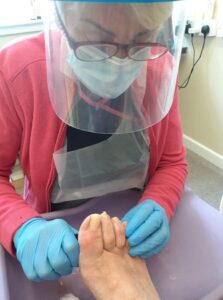Foot Care Services in New Mills
Qualified Foot Health Practitioner • Trained with the SMAE Institute
Welcome to my friendly and professional foot care clinic in New Mills. As a fully qualified Foot Health Practitioner, trained with the highly respected SMAE Institute, I provide safe, gentle and effective treatments for a wide range of foot concerns.
Please don’t ever feel embarrassed about your feet — I genuinely enjoy my work, and I take pride in helping people feel more comfortable, confident and pain-free. Every appointment is relaxed, supportive and tailored to your needs.
I proudly welcome clients from New Mills and the surrounding areas, including Hayfield, Disley, High Lane, Chinley, Buxworth and Whaley Bridge.
For those unable to visit the clinic, I also offer home visits for housebound clients.
Foot Care Treatments Available
Routine Nail Cutting & Nail Care
Safe, gentle nail trimming to prevent discomfort, reduce the risk of ingrown nails and help maintain healthy feet — ideal if you struggle to care for your nails at home.
Corn Removal
Corns can cause sharp, persistent pain when walking. I provide careful and effective removal to relieve pressure and bring instant comfort.
Callus Reduction
Hard skin and callus can make walking uncomfortable. Using professional techniques, I reduce callused areas safely, leaving feet smooth and pain-free.
Ingrown Toenail Treatment
Ingrown toenails can be painful and easily become infected. I offer gentle treatment to reduce swelling, ease discomfort and help prevent the problem from returning.
Thickened Nail Treatment
Thick or difficult-to-cut nails can result from age, trauma or infection. I use specialist tools to safely thin and manage the nail for improved comfort.
Fungal Nail Management 
I can help improve the appearance of fungal-affected nails and offer guidance on long-term management and prevention.
Verruca Treatment
Verrucae can be stubborn and uncomfortable. I provide safe, hygienic treatment options personalised to your condition.
Why Choose My Foot Care Clinic?
-
Trained with the SMAE Institute
-
Gentle, caring and professional approach
-
Safe, hygienic, patient-focused treatments
-
Convenient New Mills location
-
Covering Hayfield, Disley, High Lane, Chinley, Buxworth & Whaley Bridge
-
Home visits available for housebound clients
-
Ideal for those with mobility issues or ongoing foot concerns
-
Supportive, relaxed appointments with no judgement
Book Your Appointment
Healthy feet can make a big difference to your daily comfort and wellbeing. Whether you need routine nail cutting, help with corns or callus, or treatment for fungal nails or verrucae, I’m here to help.
Get in touch today to book your appointment in New Mills or the surrounding areas, or to arrange a home visit.


